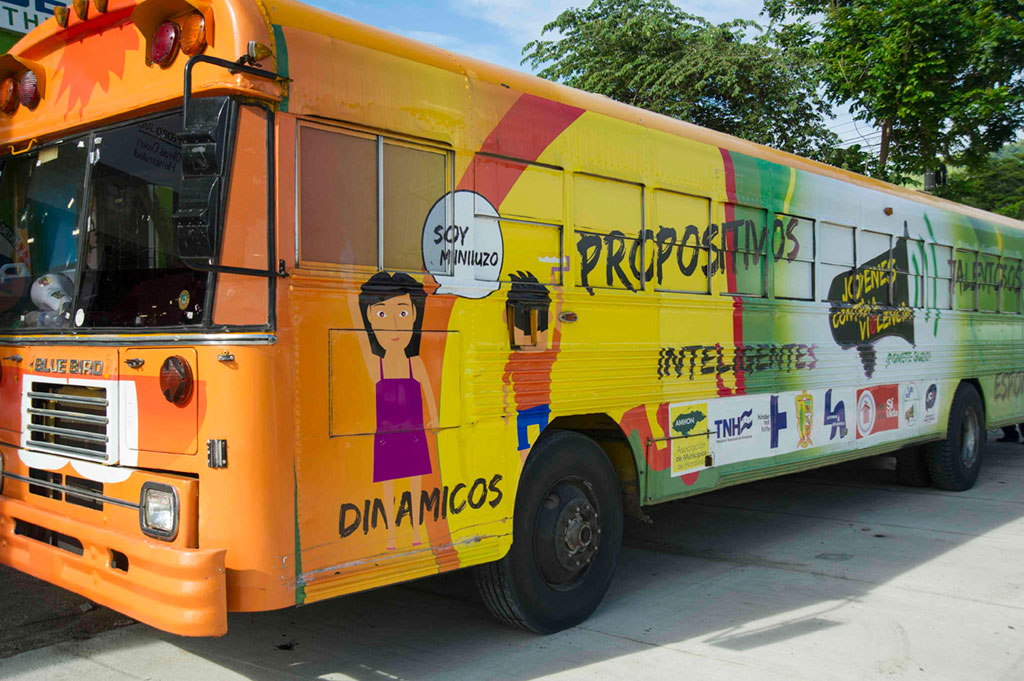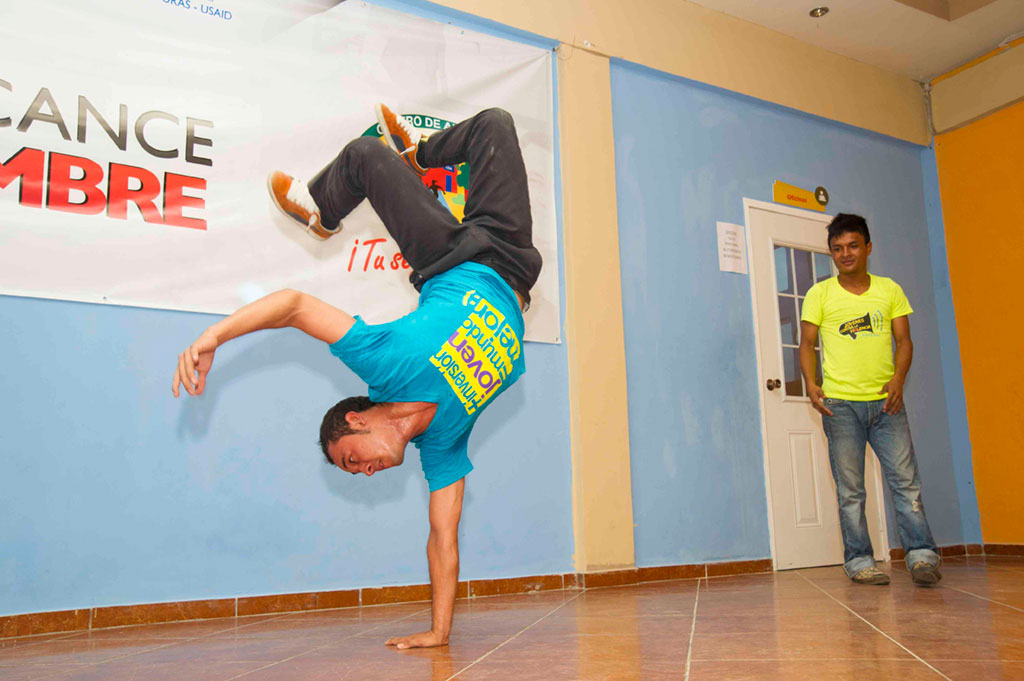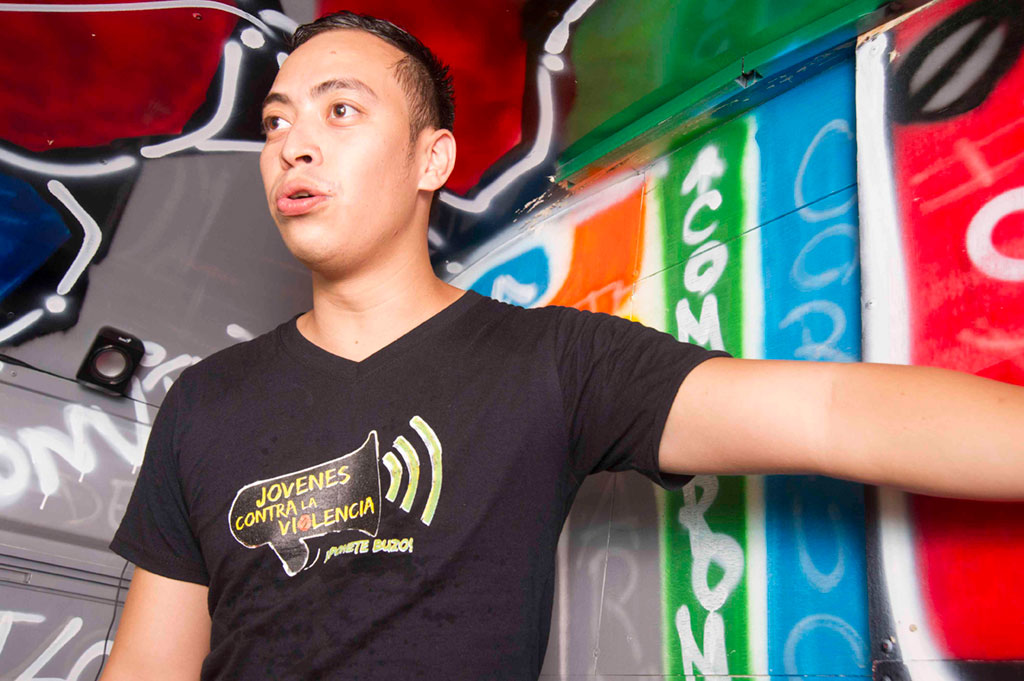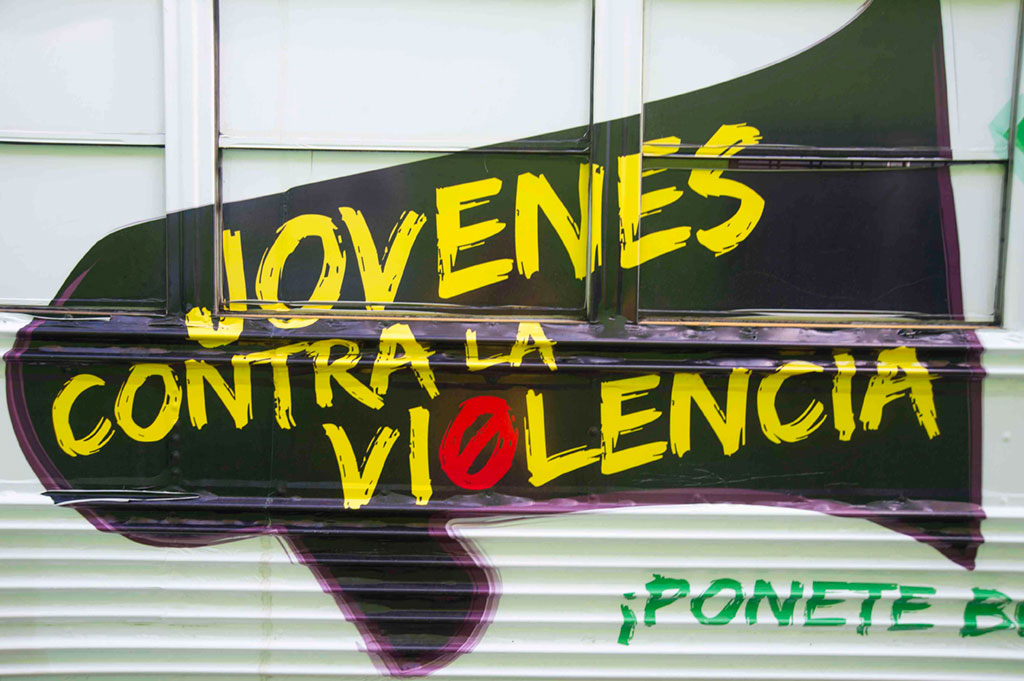San Pedro Sula, Honduras—A colorfully painted refurbished school bus arrives in Chamelecón, one of San Pedro Sula’s most at-risk neighborhoods, and a dozen teenagers in matching orange, green and blue t-shirts pile out. They are members of Jóvenes Contra la Violencia (the Youth against Violence movement), and they have an important message for kids in this high-crime community.
“One of the goals, which is essential for us, is to reduce violence in the country,” says Cecilio Torres, a leader of the movement in the city of Choloma and a former gang member. “We create prevention with messages of peace, campaigns and talks in schools and colleges to change ideologies as this wave of violence that is destroying our country.”
The multicolor bus, which the group drives around the country, is painted with anti-violence signs on the outside and, inside, displays graffiti-like messages of nonviolence illuminated with black lights and disco balls.

As kids tour the bus’s three sections, the movement’s members engage them in conversations about Honduras’s epidemic levels of violence, how to prevent this and how to become agents of positive change in their communities. As they leave the bus, kids write down one way they will make a difference in the fight against violence.
The 20-minute experience is intense and eye-opening.
For many, it is personal as they have already lost friends and family to the violence, largely driven by drugs and gangs.
Esther Ochoa knows what that is like. In 2008, one of her best friends became another victim of violence. She says that even after her friend’s death, she still did not fully realize the extent of Honduras’s violence epidemic until she joined the movement.
Now the Coordinator of the Tegucigalpa chapter, Ochoa is reaching out to educate and empower others so they do not have to experience the pain she did.
“We work in the area of violence prevention, giving these young people opportunities, saying that yes, there is a tomorrow,” says Ochoa. “We teach them not only how to the work for Youth against Violence, but how they can also work from their communities; from their families—because that is where our work begins.”
A transformative campaign

The movement was born in Guatemala in 2009 as part of the Guatemala Youth Challenge Program, a youth violence prevention program funded by the U.S. Agency for International Development and implemented by Creative Associates International.
Today the movement works in seven Central American countries. In Honduras, it receives support from the private sector, the government and Alianza Joven Honduras (Youth Alliance Honduras), a youth violence prevention program run by USAID and Creative, in partnership with the Honduran government..
“Youth against Violence began in Honduras with a massive call, something never before seen on the part of youth,” says Santiago Avila, National Coordinator of the movement. “It was a call answered by thousands of young people who decided to say ‘yes to life, no to violence.’”
The group began as a close-knit team of youth with a big idea. Avila says, “for me was at first a family; a family in which volunteers invest their time, their ideas and their talents and began to propose ideas that at one point we saw as a dream.”
Today, he says, this dream has become a reality as the movement has coalesced into a strong organization reaching some of the most vulnerable youth and communities. The movement, he says, is a pioneer, transforming the way society views youth and the conversation around violence prevention.
“I remember three or four years ago in the country, we spoke very little about violence prevention. It was even less likely that young people would start talking about violence prevention,” says Avila.
In an environment where young people are both the primary victims and perpetrators of crime, having a candid, nationwide conversation about youth and with youth on this issues is critical. Avila is clear that the movement is not out to shame youth offenders, but rather to address the factors that lead them to commit these acts.
“We are against violence. We believe that all young people, including young people who have committed unlawful acts have a way out of this.”
Broadcasting nonviolence

Guiding kids through tours aboard the movement’s bus is only one of many methods the group deploys to get their message out.
Since 2012, the group started its own television program, which airs nationally once a week and is often re-broadcast during the week. The show is filmed live on Saturdays in Tegucigalpa and is available online. A few local chapters have developed their own TV and radio programs.
Ochoa, the Coordinator of the Tegucigalpa chapter, oversees the national show, taking on a multifaceted role. Everyone involved in the production is young.
“We are cameramen. We are presenters and editors. We are everything within the program, but we know that at the same time this helps us develop many skills in professional life,” she says.
Each episode presents different risk factors for violence in a “youthful way” with music, games and entertainment, Ochoa says, which resonates with her peers around the country. The show’s hosts discuss how to combat risk factors to avoid getting caught up in violence.
A ripple effect

The activities of the Youth against Violence movement are the means of delivering a powerful message, but, as Avila explains, they are not the ends.
The bus, TV show and other campaigns are important because of their power to reach many people, he says, but what they really seek is to “to generate processes in which the main objective is to achieve empowerment and local capacity.”
Avila says he and his fellow members aspire to spark a change in every young person they reach in communities around the country so that they become agents of positive change and messengers of nonviolence.
Those in their teens and twenties are not the only ones with potential to spark this chain of transformation, they believe.
Torres, a leader in Choloma, launched the “Mini-Buzos,” a movement of children dedicated to fighting violence alongside their older counterparts. With Torres’s support, the Mini-Buzos lead campaigns of to educate their peers and community, including a campaign spreading hugs and messages of peace to friends and neighbors.
The work in not only changing the Mini-Buzos and their communities, but Torres, a former gang member, is finding purpose as well.
“On a daily basis, I am motivating and encouraging them to always support the community to do things for young people,” says Torres. “Our work here is quite different from other places because it is a youth organization for youth.”
With reporting by Emanuel Rodriguez in Honduras.
